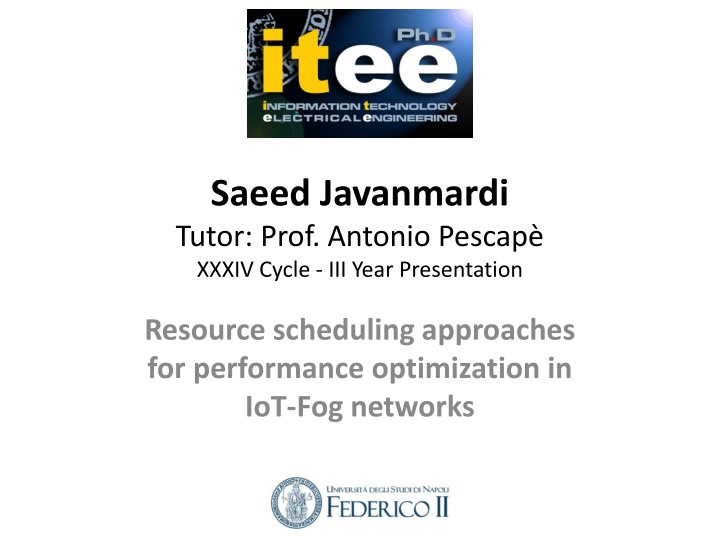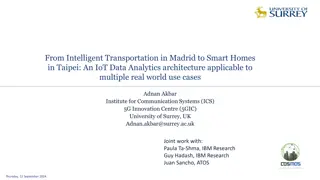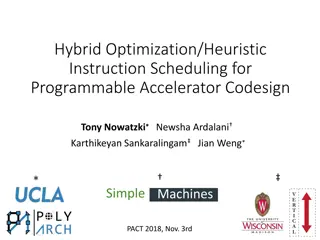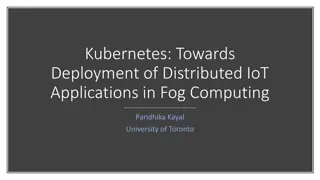Resource Scheduling Approaches for Performance Optimization in IoT-Fog Networks
Presentation on leveraging Fog resources using bio-inspired hybrid approach for performance optimization in IoT-Fog networks. Proposal includes PSO-fuzzy based scheduler for dynamic environments. Results show improvement in delay and network utilization.
Download Presentation

Please find below an Image/Link to download the presentation.
The content on the website is provided AS IS for your information and personal use only. It may not be sold, licensed, or shared on other websites without obtaining consent from the author.If you encounter any issues during the download, it is possible that the publisher has removed the file from their server.
You are allowed to download the files provided on this website for personal or commercial use, subject to the condition that they are used lawfully. All files are the property of their respective owners.
The content on the website is provided AS IS for your information and personal use only. It may not be sold, licensed, or shared on other websites without obtaining consent from the author.
E N D
Presentation Transcript
Saeed Javanmardi Tutor: Prof. Antonio Pescap XXXIV Cycle - III Year Presentation Resource scheduling approaches for performance optimization in IoT-Fog networks
Background Graduation: M.Sc. Degree in Computer System Architecture Engineering Fellowship: University Ph.D. grant I am a reviewer for the IEEE Systems Journal as well as Elsevier Computer Networks. Saeed Javanmardi 2
Credits summary Saeed Javanmardi 3
Internet of Things IoT and Its applications IoT has limitation in Computing capabilities Saeed Javanmardi 4
Fog Computing Fog paradigms provide solutions to IoT issues Cloud introduces new problems, that are mitigated by Fog Saeed Javanmardi 5
FPFTS: Problem statement How to leverage Fog resources? Fog is a highly distributed platform but application scheduling strategies are needed Saeed Javanmardi 6
The proposal The general approach Bio inspired hybrid approach (PSO-fuzzy based scheduler) Due to PSO suitability for global searching and its guided randomness feature, it is expected perform well in dynamic environments such as fog computing. WE use fuzzy logic to consider the resources and the requests simultaneously. Saeed Javanmardi 7
The sequence diagram Saeed Javanmardi 8
Some results Results: improvement in delay and network utilization Total Network Use Application Loop Delay 140000 900 Total network use (KB transferred) 800 120000 700 100000 600 Delay (ms) 80000 500 Concurrent Concurrent 400 60000 FCFS FCFS 300 40000 FPFTS FPFTS 200 20000 100 0 0 0 1 2 3 4 5 6 7 8 9 10 0 1 2 3 4 5 6 7 8 9 10 Number Of Users Moved Number Of Users Moved Saeed Javanmardi 9
FUPE: Problem statement How to leverage Fog resources? How to strike a balance between efficiency and security? Saeed Javanmardi 10
The proposal A Multi objective approach We present an architecture as well as a scheduler algorithm which integrate the SDN and Fog technology in the presence of the IoT services and tackles the TCP DDoS attacks. FUPE combines fuzzy logic and a multi-objective particle swarm optimization (MOPSO) algorithms supporting secure IoT task demands in the network. Saeed Javanmardi 11
Efficiency objective It is based on the fact that simultaneous consideration of the computing features of the resources and application s tasks CPU need, is suitable for resource scheduling. we use applications CPU need, and the features of fog devices (i.e., available processing capacity, available RAM size, and available fog-device link bandwidth) as the input parameters of the fuzzy based fitness function for efficiency objective. Saeed Javanmardi 12
An example of fuzzy sets Saeed Javanmardi 13
An example of fuzzy sets Saeed Javanmardi 14
An example of fuzzy rules Saeed Javanmardi 15
Security objective Using TRW-CB and Rate Limiting output as the input parameters of the fuzzy based fitness function for security objective. TRW-CB calculates the difference between TCP SYN and TCP ACK packets, just like in a TCP DDOS attack, where a malicious node creates a large number of half-open TCP connections on the targeted nodes. To counteract TCP DDOS attacks, Rate Limiting recognizes a node as malicious when it sends a large number of TCP SYN packets in a short period of time Saeed Javanmardi 16
Multi objective approach The MOPSO algorithm is used to find an optimal solution for optimization problems. To aggregate the outcome of the two objectives into one synthetic objective to obtain a single proper answer, we use the following equation in MOPSO fitness function: ??????????? = Efficiency + Security (1 ) Saeed Javanmardi 17
Some results Saeed Javanmardi 18
Some results ??+?? ???????? = (??+??+??+??) ?? ????????? = ??+?? ?? ??+?? ?????? = ?? denotes true positive, and ?? denotes false negative, ?? denotes true negatives, and ?? denotes false positive rates, respectively. Based on these equitation, ????????, ?????????, and ?????? are 0.9820, 0.9608, and 0.9800, respectively. Saeed Javanmardi 19
S-FOS: Problem statement How to leverage Fog resources? How to protect scheduling services? Saeed Javanmardi 20
The proposal A Multi objective approach for efficiency We present a novel framework for workflow scheduling that considers load balancing and delay Using NSGA-III A firewall to protect scheduling services It protects the scheduling services from TCP/UDP DDoS as well as port scanning attacks using fuzzy theory. Saeed Javanmardi 21
Multi objective approach The NSGA-III-based scheduling algorithm takes delay and load balancing into account We propose an NSGA-III approach for workflow scheduling to solve the multi-dimensional and multi-constraint optimization problem. Saeed Javanmardi 22
NSGA-III approach 2+ ?=1 2 2 ??????????? ??? ???? ??????????? ?? ??? ?=1 ???? ????????? = ????? ???? ???????? ???? ????? = ??????????? = Load balancing + Delay Saeed Javanmardi 23
Firewall approach TRW-CB is used to countermeasure TCP DDOS attack. Rate limiting is used to countermeasure UDP DDOS attack. S-FOS employs Entropy method to assess the randomness of destination port numbers associated with random variables. S-FOS generates output with a uniform distribution in the [0, 1] range using normalized entropy to detect the probed port numbers. Saeed Javanmardi 24
Sequence diagram of RL Saeed Javanmardi 25
Some results Saeed Javanmardi 26
Some results ??+?? ???????? = (??+??+??+??) ?? ????????? = ??+?? ?? ??+?? ?????? = ?? denotes true positive, and ?? denotes false negative, ?? denotes true negatives, and ?? denotes false positive rates, respectively. Based on these equitation, ????????, ?????????, and ?????? are 0.9710, 0.9608, and 0.9980, respectively. Saeed Javanmardi 27
Future direction Using federated learning for anomaly detection Using distributed controller Saeed Javanmardi 28
Publications Journal Papers Javanmardi, Saeed, et al. "FPFTS: a joint fuzzy particle swarm optimization mobility aware approach to fog task scheduling algorithm for Internet of Things devices." Software: Practice and Experience 51.12 (2021): 2519-2539. Javanmardi, Saeed, et al. "FUPE: A security driven task scheduling approach for SDN-based IoT Fog networks." Journal of Information Security and Applications 60 (2021): 102853. Javanmardi, Saeed, et al. " S-FoS: A secure workflow scheduling approach for performance optimization in SDN-based IoT-Fog networks Journal of Network and Computer Application (2022) Saeed Javanmardi 29
Thank you! ? Questions? Saeed.javanmardi@unina.it Saeed Javanmardi 30























